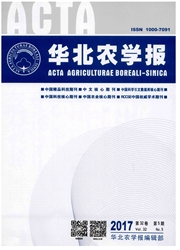

 中文摘要:
中文摘要:
利用22个微卫星标记对随机交配的野生哲罗鱼F1176个个体的生长速度相关性状(体质量、全长、体高、体宽、头长、头宽和眼间距)进行分析,22个微卫星标记共检测到67个等位基因,各座位的等位基因2~6个,片段大小为109~452 bp,平均观测杂合度和期望杂合度分别为0.583 5和0.564 0,22个位点均有不同程度的偏离Hardy-Weiberg平衡。利用SPSS软件对7个性状正态分布检测发现,7个性状都显示出连续变异的特点,属典型的数量性状或者多基因遗传,符合正态分布;同时用GLM程序对22个微卫星标记与生长速度相关性状进行相关性分析,并将与性状显著相关的标记进行基因型之间的多重比较,结果显示,22个微卫星座位中,有11个标记与至少一种性状显著相关,其中与全长相关的标记最少为4个,与体高和体宽相关的标记最多的为7个;多重比较可知每个标记中同一性状均有部分基因型差异达到显著水平,不同标记所代表均值也有些差异。上述这些标记为进一步的分子标记辅助育种提供了基础。
 英文摘要:
英文摘要:
22 microsatellite markers were used to analyze the growth rate related traits of 176 individuals from F1 of random mating Hucho taimen,including body weight,body length,body height,body width,head length,head width and interorbital width.The results showed that of the 67 alleles detected in total,the numbers of alleles ranged from 2 to 6 per locus with the fragments of 109 to 452 bp,and the mean observed heteozygosity and the mean expected heteozygosity were 0.583 5 and 0.564 0,respectively.Deviations from Hardy-Weinberg equilibrium(HWE) occurred at 22 loci in different degrees.The normal distribution of 7 traits was analyzed using SPSS software and the results indicated that all the seven traits had a characteristic of continuous variation belonging to the typical quantitative traits or polygenic inheritance traits,and conformed to the normal distribution.Meanwhile,GLM linear model was constructed between the 22 microsatellite markers and the growth rate related traits,and the markers significantly correlative to the traits were performed multiple comparison based on the genotypes.The results revealed that of 22 microsatellite loci,there were 11 markers significantly correlative to one trait at least,and the minimum number of markers related to body length was 4 and the maximum number of markers related to body height and body width was 7.Through the multiple comparisons,it was found that there was significant difference of genotypes from the same trait in every locus,and there was also difference among the mean value of the different markers.The screening of these markers could provide some basis for the further study on molecular marker-assisted breeding.
 同期刊论文项目
同期刊论文项目
 同项目期刊论文
同项目期刊论文
 期刊信息
期刊信息
